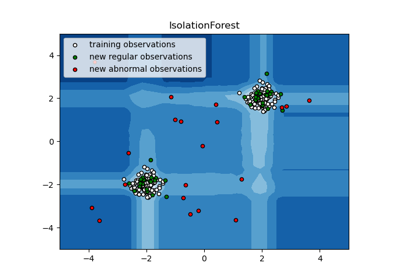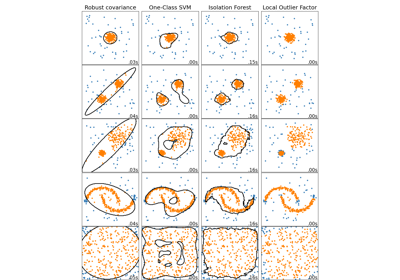sklearn.ensemble.IsolationForest¶
-
class
sklearn.ensemble.IsolationForest(*, n_estimators=100, max_samples='auto', contamination='auto', max_features=1.0, bootstrap=False, n_jobs=None, behaviour='deprecated', random_state=None, verbose=0, warm_start=False)[source]¶ Isolation Forest Algorithm.
Return the anomaly score of each sample using the IsolationForest algorithm
The IsolationForest ‘isolates’ observations by randomly selecting a feature and then randomly selecting a split value between the maximum and minimum values of the selected feature.
Since recursive partitioning can be represented by a tree structure, the number of splittings required to isolate a sample is equivalent to the path length from the root node to the terminating node.
This path length, averaged over a forest of such random trees, is a measure of normality and our decision function.
Random partitioning produces noticeably shorter paths for anomalies. Hence, when a forest of random trees collectively produce shorter path lengths for particular samples, they are highly likely to be anomalies.
Read more in the User Guide.
New in version 0.18.
- Parameters
- n_estimatorsint, default=100
The number of base estimators in the ensemble.
- max_samples“auto”, int or float, default=”auto”
- The number of samples to draw from X to train each base estimator.
If int, then draw
max_samplessamples.If float, then draw
max_samples * X.shape[0]samples.If “auto”, then
max_samples=min(256, n_samples).
If max_samples is larger than the number of samples provided, all samples will be used for all trees (no sampling).
- contamination‘auto’ or float, default=’auto’
The amount of contamination of the data set, i.e. the proportion of outliers in the data set. Used when fitting to define the threshold on the scores of the samples.
If ‘auto’, the threshold is determined as in the original paper.
If float, the contamination should be in the range [0, 0.5].
Changed in version 0.22: The default value of
contaminationchanged from 0.1 to'auto'.- max_featuresint or float, default=1.0
The number of features to draw from X to train each base estimator.
If int, then draw
max_featuresfeatures.If float, then draw
max_features * X.shape[1]features.
- bootstrapbool, default=False
If True, individual trees are fit on random subsets of the training data sampled with replacement. If False, sampling without replacement is performed.
- n_jobsint, default=None
The number of jobs to run in parallel for both
fitandpredict.Nonemeans 1 unless in ajoblib.parallel_backendcontext.-1means using all processors. See Glossary for more details.- behaviourstr, default=’deprecated’
This parameter has no effect, is deprecated, and will be removed.
New in version 0.20:
behaviouris added in 0.20 for back-compatibility purpose.Deprecated since version 0.20:
behaviour='old'is deprecated in 0.20 and will not be possible in 0.22.Deprecated since version 0.22:
behaviourparameter is deprecated in 0.22 and removed in 0.24.- random_stateint or RandomState, default=None
Controls the pseudo-randomness of the selection of the feature and split values for each branching step and each tree in the forest.
Pass an int for reproducible results across multiple function calls. See Glossary.
- verboseint, default=0
Controls the verbosity of the tree building process.
- warm_startbool, default=False
When set to
True, reuse the solution of the previous call to fit and add more estimators to the ensemble, otherwise, just fit a whole new forest. See the Glossary.New in version 0.21.
- Attributes
- estimators_list of DecisionTreeClassifier
The collection of fitted sub-estimators.
estimators_samples_list of arraysThe subset of drawn samples for each base estimator.
- max_samples_int
The actual number of samples.
- offset_float
Offset used to define the decision function from the raw scores. We have the relation:
decision_function = score_samples - offset_.offset_is defined as follows. When the contamination parameter is set to “auto”, the offset is equal to -0.5 as the scores of inliers are close to 0 and the scores of outliers are close to -1. When a contamination parameter different than “auto” is provided, the offset is defined in such a way we obtain the expected number of outliers (samples with decision function < 0) in training.New in version 0.20.
- estimators_features_list of arrays
The subset of drawn features for each base estimator.
See also
sklearn.covariance.EllipticEnvelopeAn object for detecting outliers in a Gaussian distributed dataset.
sklearn.svm.OneClassSVMUnsupervised Outlier Detection. Estimate the support of a high-dimensional distribution. The implementation is based on libsvm.
sklearn.neighbors.LocalOutlierFactorUnsupervised Outlier Detection using Local Outlier Factor (LOF).
Notes
The implementation is based on an ensemble of ExtraTreeRegressor. The maximum depth of each tree is set to
ceil(log_2(n))where \(n\) is the number of samples used to build the tree (see (Liu et al., 2008) for more details).References
- 1
Liu, Fei Tony, Ting, Kai Ming and Zhou, Zhi-Hua. “Isolation forest.” Data Mining, 2008. ICDM’08. Eighth IEEE International Conference on.
- 2
Liu, Fei Tony, Ting, Kai Ming and Zhou, Zhi-Hua. “Isolation-based anomaly detection.” ACM Transactions on Knowledge Discovery from Data (TKDD) 6.1 (2012): 3.
Examples
>>> from sklearn.ensemble import IsolationForest >>> X = [[-1.1], [0.3], [0.5], [100]] >>> clf = IsolationForest(random_state=0).fit(X) >>> clf.predict([[0.1], [0], [90]]) array([ 1, 1, -1])
Methods
Average anomaly score of X of the base classifiers.
fit(X[, y, sample_weight])Fit estimator.
fit_predict(X[, y])Perform fit on X and returns labels for X.
get_params([deep])Get parameters for this estimator.
predict(X)Predict if a particular sample is an outlier or not.
Opposite of the anomaly score defined in the original paper.
set_params(**params)Set the parameters of this estimator.
-
__init__(*, n_estimators=100, max_samples='auto', contamination='auto', max_features=1.0, bootstrap=False, n_jobs=None, behaviour='deprecated', random_state=None, verbose=0, warm_start=False)[source]¶ Initialize self. See help(type(self)) for accurate signature.
-
decision_function(X)[source]¶ Average anomaly score of X of the base classifiers.
The anomaly score of an input sample is computed as the mean anomaly score of the trees in the forest.
The measure of normality of an observation given a tree is the depth of the leaf containing this observation, which is equivalent to the number of splittings required to isolate this point. In case of several observations n_left in the leaf, the average path length of a n_left samples isolation tree is added.
- Parameters
- X{array-like, sparse matrix} of shape (n_samples, n_features)
The input samples. Internally, it will be converted to
dtype=np.float32and if a sparse matrix is provided to a sparsecsr_matrix.
- Returns
- scoresndarray of shape (n_samples,)
The anomaly score of the input samples. The lower, the more abnormal. Negative scores represent outliers, positive scores represent inliers.
-
property
estimators_samples_¶ The subset of drawn samples for each base estimator.
Returns a dynamically generated list of indices identifying the samples used for fitting each member of the ensemble, i.e., the in-bag samples.
Note: the list is re-created at each call to the property in order to reduce the object memory footprint by not storing the sampling data. Thus fetching the property may be slower than expected.
-
fit(X, y=None, sample_weight=None)[source]¶ Fit estimator.
- Parameters
- X{array-like, sparse matrix} of shape (n_samples, n_features)
The input samples. Use
dtype=np.float32for maximum efficiency. Sparse matrices are also supported, use sparsecsc_matrixfor maximum efficiency.- yIgnored
Not used, present for API consistency by convention.
- sample_weightarray-like of shape (n_samples,), default=None
Sample weights. If None, then samples are equally weighted.
- Returns
- selfobject
Fitted estimator.
-
fit_predict(X, y=None)[source]¶ Perform fit on X and returns labels for X.
Returns -1 for outliers and 1 for inliers.
- Parameters
- X{array-like, sparse matrix, dataframe} of shape (n_samples, n_features)
- yIgnored
Not used, present for API consistency by convention.
- Returns
- yndarray of shape (n_samples,)
1 for inliers, -1 for outliers.
-
get_params(deep=True)[source]¶ Get parameters for this estimator.
- Parameters
- deepbool, default=True
If True, will return the parameters for this estimator and contained subobjects that are estimators.
- Returns
- paramsmapping of string to any
Parameter names mapped to their values.
-
predict(X)[source]¶ Predict if a particular sample is an outlier or not.
- Parameters
- X{array-like, sparse matrix} of shape (n_samples, n_features)
The input samples. Internally, it will be converted to
dtype=np.float32and if a sparse matrix is provided to a sparsecsr_matrix.
- Returns
- is_inlierndarray of shape (n_samples,)
For each observation, tells whether or not (+1 or -1) it should be considered as an inlier according to the fitted model.
-
score_samples(X)[source]¶ Opposite of the anomaly score defined in the original paper.
The anomaly score of an input sample is computed as the mean anomaly score of the trees in the forest.
The measure of normality of an observation given a tree is the depth of the leaf containing this observation, which is equivalent to the number of splittings required to isolate this point. In case of several observations n_left in the leaf, the average path length of a n_left samples isolation tree is added.
- Parameters
- X{array-like, sparse matrix} of shape (n_samples, n_features)
The input samples.
- Returns
- scoresndarray of shape (n_samples,)
The anomaly score of the input samples. The lower, the more abnormal.
-
set_params(**params)[source]¶ Set the parameters of this estimator.
The method works on simple estimators as well as on nested objects (such as pipelines). The latter have parameters of the form
<component>__<parameter>so that it’s possible to update each component of a nested object.- Parameters
- **paramsdict
Estimator parameters.
- Returns
- selfobject
Estimator instance.


